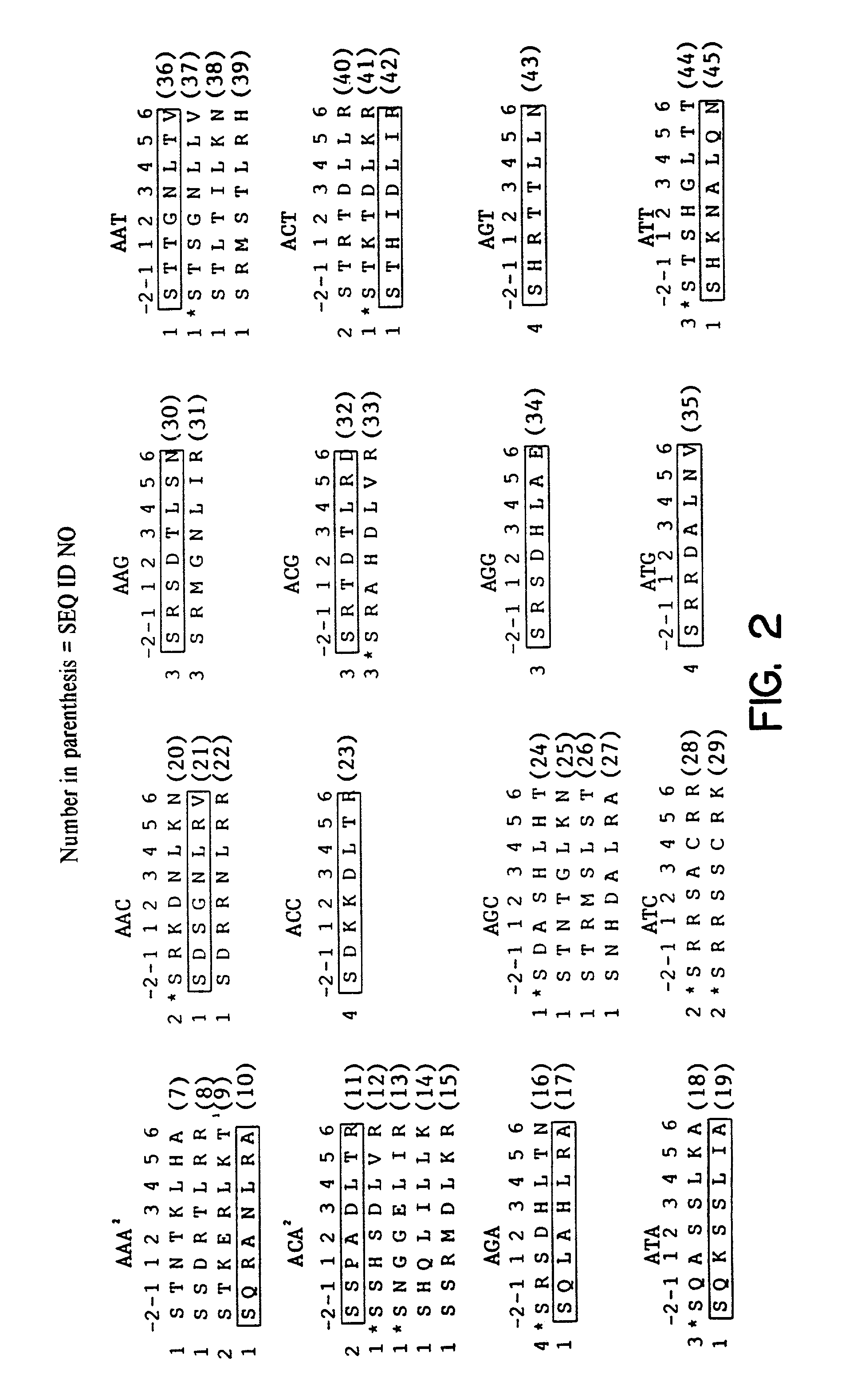Zinc finger binding domains for nucleotide sequence ANN
a technology of nucleotide sequences and zinc finger proteins, which is applied in the direction of peptides, peptide/protein ingredients, peptide sources, etc., can solve the problems of inability to rationally design zinc proteins and high time consumption, and achieve the effect of increasing the number of sequences and achieving excellent binding specificity
- Summary
- Abstract
- Description
- Claims
- Application Information
AI Technical Summary
Benefits of technology
Problems solved by technology
Method used
Image
Examples
example 1
Construction of Zinc Finger Library and Selection Via Phage Display
[0072]Construction of the zinc finger library was based on the earlier described C7 protein ([Wu et al., (1995) PNAS 92, 344–348]; FIG. 1a, upper panel). Finger 3 recognizing the 5′-GCG-3′ subsite was replaced by a domain binding to a 5′-GAT-3′ subsite [Segal et al., (1999) Proc Natl Acad Sci USA 96(6), 2758–2763] via a overlap PCR strategy using a primer coding for finger 3 (5′-GAGGAAGTTTGCCACCAGTGGCAACCTG GTGAGGCATACCAAAATC-3′) (SEQ ID NO: 104) and a pMal-specific primer (5′-GTAAAACGACGGCCAGTGCCAAGC-3′) (SEQ ID NO: 105). Randomization the zinc finger library by PCR overlap extension was essentially as described [Wu et al., (1995) PNAS92, 344–348; Segal et al., (1999) Proc Natl Acad Sci USA 96(6), 2758–2763]. The library was ligated into the phagemid vector pComb3H [Rader et al., (1997) Curr. Opin. Biotechnol. 8(4), 503–508]. Growth and precipitation of phage were performed as previously described [Barbas et al., (1...
example 2
Site-Directed Mutagenesis of Finger 2
[0075]Finger-2 mutants were constructed by PCR as described [Segal et al., (1999) Proc Natl Acad Sci USA 96(6), 2758–2763; Dreier et al., (2000) J. Mol. Biol. 303, 489–502]. As PCR template the library clone containing 5′-TGG-3′ finger 2 and 5′-GAT-3′ finger 3 was used. PCR products containing a mutagenized finger 2 and 5′-GAT-3′ finger 3 were subcloned via NsiI and SpeI restriction sites in frame with finger 1 of C7 into a modified pMal-c2 vector (New England Biolabs).
[0076]Construction of Polydactyl Zinc Finger Proteins—Three-finger proteins were constructed by finger-2 stitchery using the SP1C framework as described [Beerli et al., (1998) Proc Natl Acad Sci USA 95(25), 14628–14633]. The proteins generated in this work contained helices recognizing 5′-GNN-3′ DNA sequences [Segal et al., (1999) Proc Natl Acad Sci USA 96(6), 2758–2763], as well as 5′-ANN-3′ and 5′-TAG-3′ helic described here. Six finger proteins were assembled via compatible XmaI...
example 3
General Methods
Transfection and Luciferase Assays
[0077]HeLa cells were used at a confluency of 40–60%. Cells were transfected with 160 ng reporter plasmid (pGL3-promoter constructs) and 40 ng of effector plasmid (zinc finger-effector domain fusions in pcDNA3) in 24 well plates. Cell extracts were prepared 48 hrs after transfection and measured with luciferase assay reagent (Promega) in a MicroLumat LB96P luminometer (EG & Berthold, Gaithersburg, Md.).
Retroviral Gene Targeting and Flow Cytometric Analysis
[0078]These assays were performed as described [Beerli et al., (2000) Proc Natl Acad Sci USA 97(4), 1495–1500; Beerli et al., (2000) J. Biol. Chem. 275(42), 32617–32627]. As primary antibody an ErbB-1-specific mAb EGFR (Santa Cruz), ErbB-2-specific mAb FSP77 (gift from Nancy E. Hynes; Harwerth et al., 1992) and an ErbB-3-specific mAb SGP1 (Oncogene Research Products) were used. Fluorescently labeled donkey F(ab′)2 anti-mouse IgG was used as secondary antibody (Jackson Immuno-Research...
PUM
| Property | Measurement | Unit |
|---|---|---|
| Gene expression profile | aaaaa | aaaaa |
Abstract
Description
Claims
Application Information
 Login to View More
Login to View More - R&D
- Intellectual Property
- Life Sciences
- Materials
- Tech Scout
- Unparalleled Data Quality
- Higher Quality Content
- 60% Fewer Hallucinations
Browse by: Latest US Patents, China's latest patents, Technical Efficacy Thesaurus, Application Domain, Technology Topic, Popular Technical Reports.
© 2025 PatSnap. All rights reserved.Legal|Privacy policy|Modern Slavery Act Transparency Statement|Sitemap|About US| Contact US: help@patsnap.com



